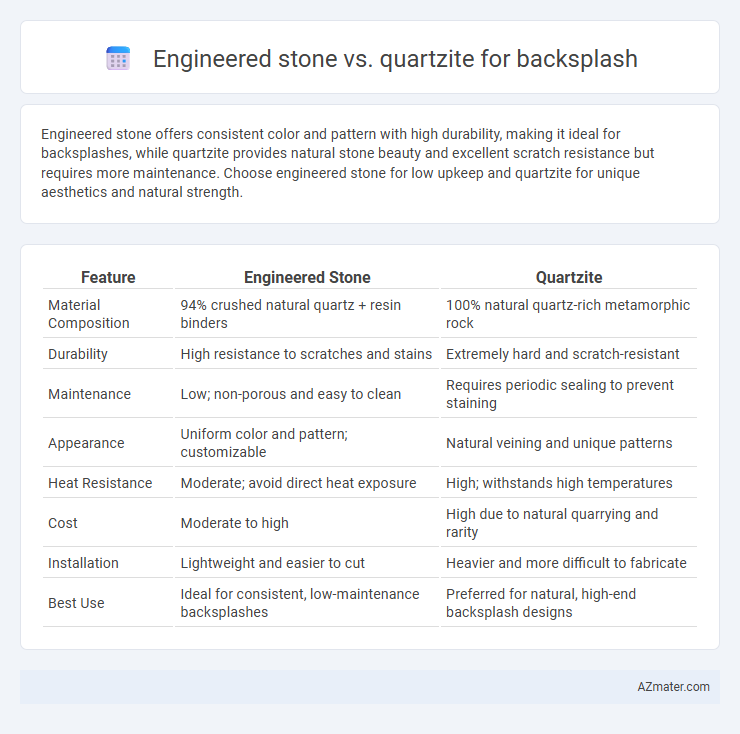Engineered stone offers consistent color and pattern with high durability, making it ideal for backsplashes, while quartzite provides natural stone beauty and excellent scratch resistance but requires more maintenance. Choose engineered stone for low upkeep and quartzite for unique aesthetics and natural strength.
Table of Comparison
| Feature | Engineered Stone | Quartzite |
|---|---|---|
| Material Composition | 94% crushed natural quartz + resin binders | 100% natural quartz-rich metamorphic rock |
| Durability | High resistance to scratches and stains | Extremely hard and scratch-resistant |
| Maintenance | Low; non-porous and easy to clean | Requires periodic sealing to prevent staining |
| Appearance | Uniform color and pattern; customizable | Natural veining and unique patterns |
| Heat Resistance | Moderate; avoid direct heat exposure | High; withstands high temperatures |
| Cost | Moderate to high | High due to natural quarrying and rarity |
| Installation | Lightweight and easier to cut | Heavier and more difficult to fabricate |
| Best Use | Ideal for consistent, low-maintenance backsplashes | Preferred for natural, high-end backsplash designs |
Introduction to Engineered Stone and Quartzite for Backsplash
Engineered stone for backsplashes combines natural quartz with resins and pigments, offering a non-porous, durable surface resistant to stains and scratches. Quartzite, a natural metamorphic rock, provides unique veining patterns and superior heat resistance, making it a luxurious and long-lasting choice for backsplash installations. Both materials enhance kitchen aesthetics, but engineered stone offers easier maintenance while quartzite demands more care due to its natural porosity.
Composition: Engineered Stone vs Quartzite
Engineered stone is composed primarily of crushed quartz mixed with resin and pigments, offering consistent color and pattern options ideal for backsplashes. Quartzite is a natural metamorphic rock formed from sandstone, characterized by its durability and unique veining patterns that vary with each slab. The resin in engineered stone enhances stain resistance and flexibility, while quartzite's natural hardness provides superior heat and scratch resistance for kitchen applications.
Durability and Strength Comparison
Engineered stone offers superior durability with consistent resistance to stains, scratches, and chips due to its composite materials and resin binders. Quartzite, a natural stone, provides exceptional strength and heat resistance but can be prone to etching and requires periodic sealing to maintain its durability. For backsplashes, engineered stone ensures low maintenance and long-lasting performance, while quartzite offers a unique natural aesthetic combined with solid structural integrity.
Aesthetic Options and Design Versatility
Engineered stone offers a wide range of color options and consistent patterns, making it ideal for customized backsplashes that require uniformity and vibrant hues. Quartzite provides natural veining and unique textures that add organic elegance and timeless beauty to backsplash designs. Both materials enhance design versatility, with engineered stone suited for modern, sleek styles and quartzite perfect for rustic or classic aesthetics.
Color and Pattern Availability
Engineered stone offers a broad spectrum of color and pattern options, allowing homeowners to find precise design matches for backsplashes, including consistent veining and vibrant hues. Quartzite, a natural stone, presents unique, organic patterns with subtle color variations that enhance a backsplash's aesthetic with a one-of-a-kind appearance. While engineered stone delivers uniformity and predictable designs, quartzite provides distinctive textures and natural beauty for those seeking a more authentic stone look.
Maintenance Requirements and Cleaning
Engineered stone backsplashes require minimal maintenance due to their non-porous surface, resisting stains and bacteria without sealing. Quartzite backsplashes demand regular sealing to prevent staining and etching from acidic substances, making upkeep more intensive. Cleaning engineered stone involves mild soap and water, while quartzite needs pH-neutral cleaners to preserve its natural durability.
Stain and Heat Resistance
Engineered stone offers superior stain resistance due to its non-porous surface, making it less prone to discoloration from spills and everyday kitchen use. Quartzite, being a natural stone, typically requires regular sealing to protect against stains and can be more susceptible to etching from acidic substances. When it comes to heat resistance, quartzite can withstand higher temperatures compared to engineered stone, which may suffer damage or discoloration from direct heat exposure.
Installation Process and Considerations
Engineered stone offers a consistent texture and easier fabrication, allowing for precise cuts and straightforward installation on backsplashes with minimal risk of chipping. Quartzite, being a natural stone, requires specialized tools and experienced installers due to its hardness and brittleness, which can complicate the cutting and fitting process. Both materials necessitate proper sealing to protect against stains, but engineered stone typically demands less maintenance after installation compared to quartzite.
Cost Differences and Budget Factors
Engineered stone backsplashes typically cost between $50 and $100 per square foot, offering a more affordable option compared to quartzite, which ranges from $70 to $150 per square foot due to its natural stone origin. Budget factors include installation expenses, with quartzite requiring specialized labor that increases overall costs, while engineered stone installations are generally less labor-intensive. Choosing engineered stone often suits tighter budgets without sacrificing aesthetic appeal, whereas quartzite provides unique veining and durability at a premium price point.
Environmental Impact and Sustainability
Engineered stone for backsplashes is manufactured using resin and crushed natural quartz, resulting in a consistent product but with higher embodied carbon due to synthetic materials. Quartzite is a natural metamorphic rock mined directly from quarries, offering better environmental sustainability because it requires less processing and contains no resins or adhesives. Choosing quartzite reduces the ecological footprint and supports environmentally responsible construction practices by minimizing chemical use and fostering longevity.

Infographic: Engineered stone vs Quartzite for Backsplash
 azmater.com
azmater.com